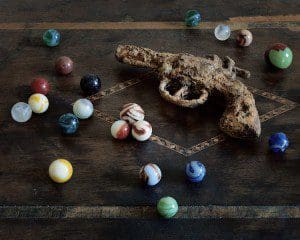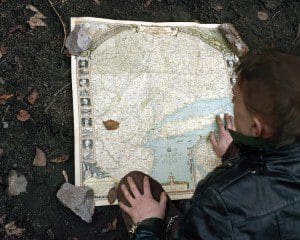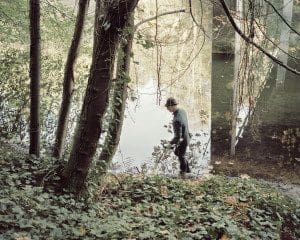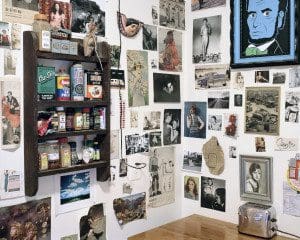
When I first met Jenny Riffle, she had already been photographing her boyfriend, Riley, for several years. Their one-bedroom apartment was intricately arranged with Riley’s findings: a large poster advertising Raleigh cigarettes, which he found behind the drywall in an abandoned building; old calcified revolvers and rusty shotgun bullets he collected while metal-detecting off of forest pathways; and cloudy bottles of various sizes, softened by years of sifting Brooklyn beach sand. Doll heads with cheeks too rosy and features dulled by wear leered from corners, and old clippings of cars hung tacked to the wall above their gold couch. There in that one-bedroom apartment in Seattle’s Capitol Hill I had found a collection of treasures, meticulously cleaned and arranged by their finders into a collection of consumerism turned junk.
But I first came to know Riffle’s photography through her younger sister—my girlfriend, Emily. Riffle has been taking photographs of Emily once a year on her birthday, since Emily was 15. Similar to Nicholas Nixon’s “The Brown Sisters,” a series of photographs taken each year of Nixon’s wife and her sisters, “Emily” works as a compilation and a meditation on time. By continuing to reexamine a subject, Riffle accrues images that simulate the progression of time while simultaneously freeing the subject from the metonymy of portraiture that claims to define a person with the blink of a shutter. Besides chronicling the process of aging, “Emily” dwells on the multiplicity that makes up a single person. As Riffle, who teaches photography at the Photo Center Northwest, writes in her description of the project, “Seeing the progression of birthday photos shows how my sister has changed over the years, but in the end for me she will always encompass all the images at once.” This is what makes Riffle’s portraits like stories. They may not have classic beginnings, middles, or endings, but they have an element of wholeness that classic portraiture lacks.
It is hard to say what came first: the artist or the muse. Each one creates the other, and the same can be said of Jenny and Riley. If Riley’s talent is embodying adventure and finding treasure, then Riffle’s talent is finding the art in the adventure. In her series Scavenger: Adventures in Treasure Hunting (featured in PDN Magazine, which named her one of its top 30 new and emerging photographers to watch), Riffle chronicles her boyfriend’s explorations. Her portraits show the same meticulous care Riley gives to his treasure, while infusing America’s love for adventure stories into the quotidian. A junkyard becomes a goldmine when placed behind the gaze of the adventurer, and Riffle is there to capture that transformation.
ZYZZYVA: Storytelling seems particularly important to you in this project. Has it always been part of your approach to photography? How effective are portraits in telling a story?

Jenny Riffle: I have always been interested in creating photographs that tell stories and are a jumping off point for one’s imagination. I want the viewer to experience the world created in the photo and bring their own narratives and memories to the work.
Portraits can be very effective at telling stories. Throughout the history of photography, the portrait has fluctuated from being seen as expressing the trace or essence of the person to expressing nothing about the person in front of the camera, instead reflecting back into the head of the photographer. In my work, I realized I have always been most interested in the subtle mixing of the two, what is real about the subject and what is inside my head. When I was working on a series of portraits before the Scavenger project, I never felt that I was creating a truthful or real representation of a person. Instead, my portraits have always contained an element of fiction. I start with the subject and light to express a certain mood and build on it with the scenery and objects in the image to create a story.
As a photographer I am always telling my version of the story, with my opinions and my point of view. In my Scavenger project I focus on my boyfriend, Riley, and as the project unfolded I often got questions about the distance in the photos, how I am not showing an intimate portrait of Riley, as one might think because of our relationship. I realized that I felt less interested in showing who he really is but more interested in exploring who I see him as, my romantic view of his adventures and the iconic character that he becomes through my eyes. Referencing different stories I have read throughout my life, I portray him as a mythical hero on a quest, like Huckleberry Finn and Tom Sawyer.
Z: You reference Tom Sawyer and Huck Finn as inspirations for this work. What other inspirations from literature did you draw upon? What was your favorite book growing up?
JR: I found many inspirations in the world of fiction. I spent most of my childhood daydreaming and reading fantasy novels. I would go to second-hand stores and buy any book that looked interesting. Losing myself in the magical worlds of the books I read, I grew up with a strong sense of the mythical. I have had many favorites; when I was very young I read all the books about the Arthurian Legends, anything with magic and wizards, and fantastical animal kingdoms.
In high school I started to appreciate some of the American classics. As I Lay Dying by William Faulkner was one of the first books that I really loved. I also went through a Cormac McCarthy period and read almost all of his books. He writes a lot about people searching and wandering through the American landscape, which are certainly themes that I share.
In college and after, I found inspiration in the magical realism of Latin American writers like Gabriel García Márquez and Julio Cortázar and the Japanese writer Haruki Murakami. I love how fantasy and magic creep into the worlds created in these novels, but they only enhance the realness of the emotions.

Z: You quote Twain in your description of the series. While universal characters, Tom Sawyer and Huck Finn are also products of their Southern upbringings. Riley grew up in rural eastern Washington and you spent parts of your childhood in a cabin without electricity also in Washington. Do you think that this project resonates particularly with growing up in the Northwest? Did your rural upbringings help to develop this sense of imagination and adventure?
JR: I think both Riley and I shared a similar childhood that fostered a sense of adventure. I’m not sure it is specific to the Northwest, maybe more to a rural setting. Having the forest as your backyard provides endless entertainment and you learn to use your imagination, or at least I did, making up stories of great adventure and acting them out in the woods, building forts and staging imaginary battles.
I have shot images for this project both on the East Coast and West Coast, depending on where we are living and what places Riley has found to go treasure hunting, so I do not feel the series is completely tied to the Northwest in that sense. I do feel it is tied to American themes that run deep in our subconscious. Riley and I are both driven by the thrill of the hunt, me as the photographer searching for images and him as the scavenger searching for treasure. There is an American element in the thrill of the hunt and the adventure of heading off to find your fortune, starting way back in history with the frontier and the gold rush, the dream of going from rags to riches is an idea embedded into the American mind.
Z: Scavenger has garnered a lot of attention across the country and even overseas. Is it difficult to move on from a project like that? What are you currently working on?

JR: It is hard to move on, for several reasons. Riley and I still go out treasure hunting and I still find myself taking photos of it. I don’t know if the project will ever have a specific ending, or if slowly, over time, I will find that it is done. I have an exhibition of Scavenger that traveled around the U.S. in 2014 and is still traveling, so in a way it helped to make an edit of the images, and I feel like I have a finished series for the exhibition. But I have always felt the series should be in book form, so maybe after I have done the book edit I will feel like the project is really finished.
It is also hard to move on to the next thing because I feel like this project was such a perfect example of what I like about photography. The next project needs to feel just as right for me. I am not someone who can just jump from one thing to the next; I tend to work on themes for a long period of time, and these days it seems that everyone works on one project for six months and then is on to the next. For me, I want ten years for one project and then I will spend ten years on the next—and really they all blend together. That said I have been shooting a lot in the last three and a half years since I finished grad school and moved back to Seattle, some for Scavenger and some for a new series that I am working out: The Sound of Wind. It deals with my memories of growing up out in the woods and is very tied to the Northwest. I’ve been thinking a lot about the forest and the power it has to be both beautiful and scary.
